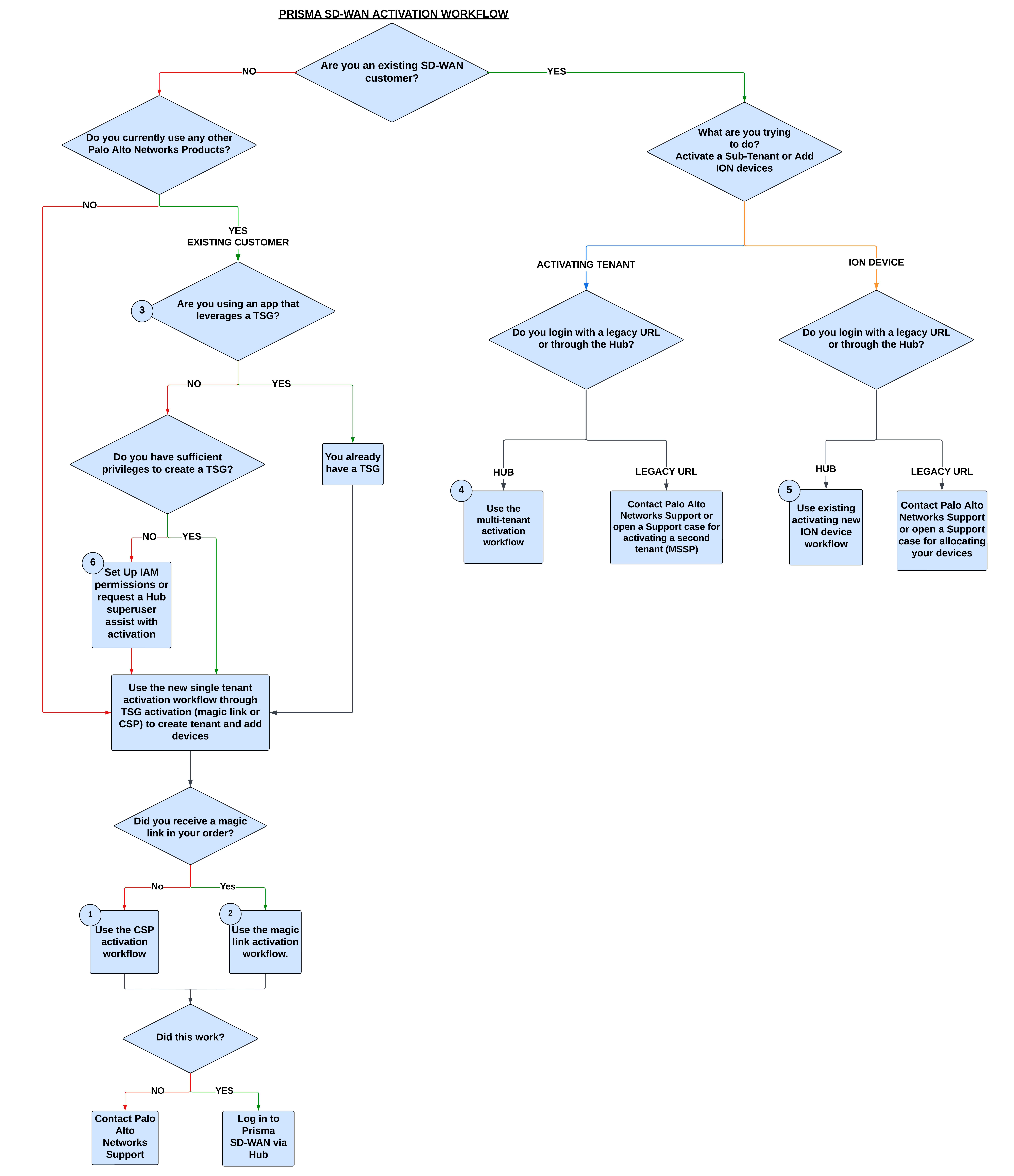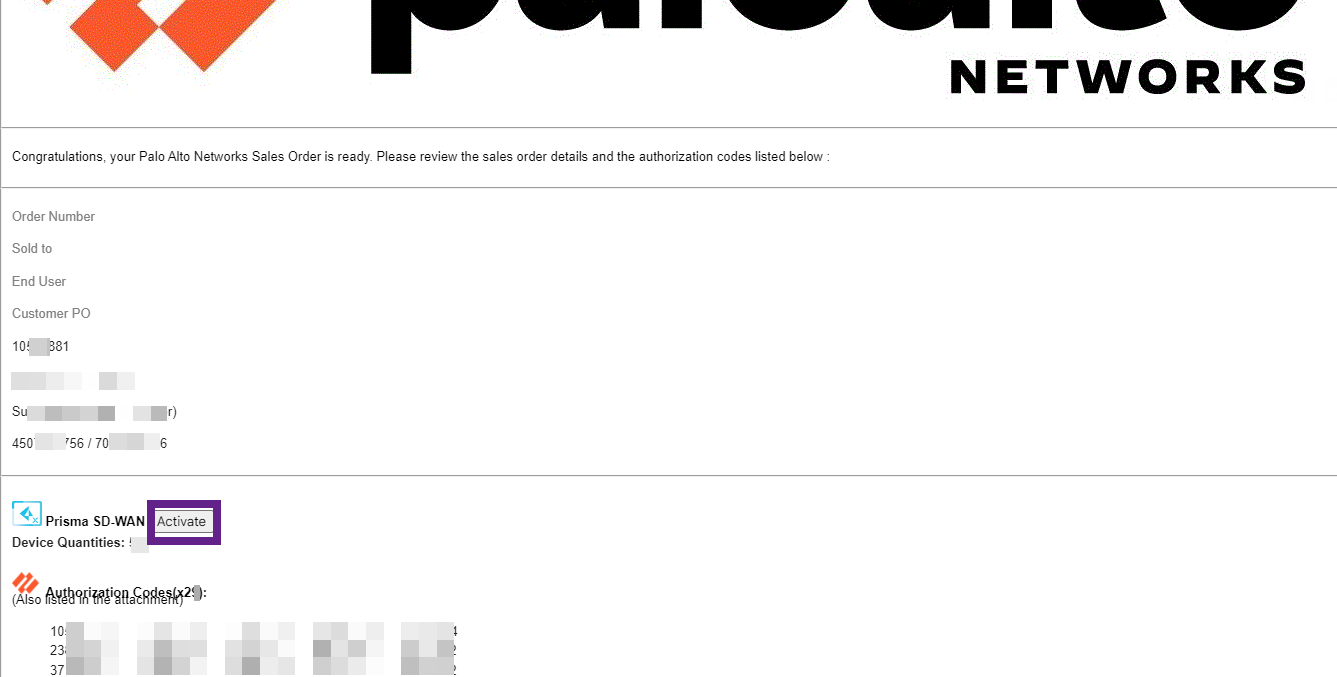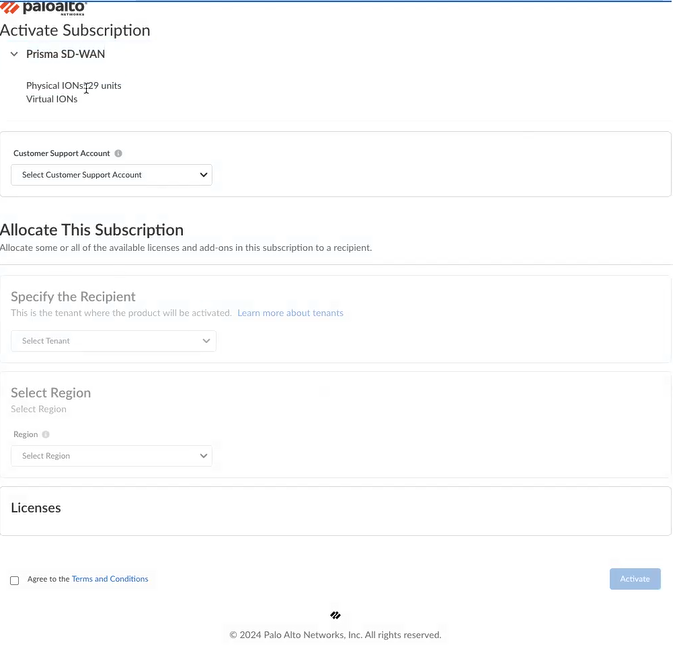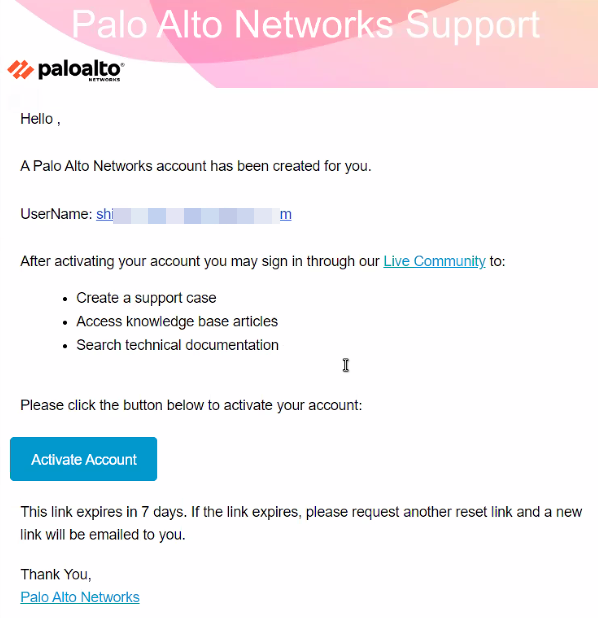Prisma SD-WAN
Activate and Launch Prisma SD-WAN
Table of Contents
Expand All
|
Collapse All
Prisma SD-WAN Docs
-
-
-
- CloudBlade Integrations
- CloudBlades Integration with Prisma Access
-
-
-
-
- 6.5
- 6.4
- 6.3
- 6.2
- 6.1
- 5.6
- New Features Guide
- On-Premises Controller
- Prisma SD-WAN CloudBlades
- Prisma Access CloudBlade Cloud Managed
- Prisma Access CloudBlade Panorama Managed
Activate and Launch Prisma SD-WAN
Let us learn to activate and launch Prisma SD-WAN.
| Where Can I Use This? | What Do I Need? |
|---|---|
|
|
Activate and launch the Prisma SD-WAN web interface based on your license. Prisma SD-WAN activation varies depending on the status of your
transition to the Prisma™ SASE Platform.

You will belong to one of the following categories:
- You are a new customer trying to create a Prisma SD-WAN tenant or allocate ION devices.
- If you have received a magic link in your order, use the guided activation work flow.
- If you have not received a magic link in your order, use the CSP activation work flow.
- You are an existing Prisma SD-WAN customer.
- You log in to Prisma SD-WAN through the Hub and are trying to allocate ION
devices.Use the steps in allocate ION devices for an existing user with a TSG-enabled tenant.
- You log in to Prisma SD-WAN with the legacy URL and
are trying to allocate ION devices.Contact Palo Alto Networks Support to open a Support case for allocating your devices.
- You log in to Prisma SD-WAN through the Hub and are
trying to activate a tenant.Use the multi-tenant activation flow to activate additional tenants.
- You log in to Prisma SD-WAN with the legacy URL and
are trying to activate a tenant.Contact Palo Alto Networks Support to open a Support case for activating a second (child) tenant.
- Your tenant has recently migrated to TSG and you have received an
email for activation.Use the steps in Create and activate your Prisma SASE account to activate your account.
- You log in to Prisma SD-WAN through the Hub and are trying to allocate ION
devices.
- You are an existing Palo Alto Networks customer.
- You use an application that leverages TSG. You are
trying to create a Prisma SD-WAN tenant or allocate
ION devices.
- If you have received a magic link in your order, use the guided activation work flow.
- If you have not received a magic link in your order, use the CSP activation work flow.
- You use an application that does NOT leverage TSG. You are trying to
create a Prisma SD-WAN tenant or allocate ION
devices.
- If you have sufficient privileges to create a TSG, then
first create a TSG and then:
- If you have received a magic link in your order, use the guided activation work flow.
- If you have not received a magic link in your order, use the CSP activation work flow.
- If you do NOT have sufficient privileges to create a TSG,
request a Superuser to grant privileges and create a TSG.
- If you have received a magic link in your order, use the guided activation work flow.
- If you have not received a magic link in your order, use the CSP activation work flow.
- If you have sufficient privileges to create a TSG, then
first create a TSG and then:
- You use an application that leverages TSG. You are
trying to create a Prisma SD-WAN tenant or allocate
ION devices.
- Activate and Launch Prisma SD-WAN using a magic link.If you have purchased your Prisma SD-WAN license and ION devices after March 2021, your order fulfillment email includes a magic link. This magic link enables you to activate your license from a tile on the Palo Alto Networks hub.To leverage the Prisma SD-WAN functionality, you must activate the Prisma SD-WAN Bandwidth or Data Center license using the magic link that you received from Palo Alto Networks. Without activating these licenses, only a base tenant will be created, which will not have the complete Prisma SD-WAN functionality.
- Activate Prisma SD-WAN.
- Locate the activation email that you have received from Palo Alto Networks and click Activate in the email.
![]()
- Enter your email address and click Sign In.
On the Activate Subscription page, select a Customer Support Account for Prisma SD-WAN.![]() Select a tenant to associate this subscription with from the Specify the Recipient drop-down.Select a Region.Prisma SD-WAN currently supports the following regions—United States, Canada, UK, Germany, Netherlands, Australia, Singapore, Japan, Israel, Switzerland, France, Saudi Arabia, Qatar, and India.Ensure that you select a region that supports Prisma SD-WAN. If you have previously activated a Palo Alto Networks product in a region that does not support Prisma SD-WAN, you will not be able to activate Prisma SD-WAN in the same tenant. In such a case, contact Palo Alto Networks to open a Support case for region allocation.Agree to the Terms and Conditions and click Activate.If the activation fails, create an Admin case for assistance. Ensure to take a screen capture of the error. Include the URL and error code in the support ticket or the link from the order fulfillment email, which you used to start the activation process. The URL and error code helps the support engineer troubleshoot the issue.Launch Prisma SD-WAN.Click the Prisma SD-WAN tile on the hub to launch the application in future.
Select a tenant to associate this subscription with from the Specify the Recipient drop-down.Select a Region.Prisma SD-WAN currently supports the following regions—United States, Canada, UK, Germany, Netherlands, Australia, Singapore, Japan, Israel, Switzerland, France, Saudi Arabia, Qatar, and India.Ensure that you select a region that supports Prisma SD-WAN. If you have previously activated a Palo Alto Networks product in a region that does not support Prisma SD-WAN, you will not be able to activate Prisma SD-WAN in the same tenant. In such a case, contact Palo Alto Networks to open a Support case for region allocation.Agree to the Terms and Conditions and click Activate.If the activation fails, create an Admin case for assistance. Ensure to take a screen capture of the error. Include the URL and error code in the support ticket or the link from the order fulfillment email, which you used to start the activation process. The URL and error code helps the support engineer troubleshoot the issue.Launch Prisma SD-WAN.Click the Prisma SD-WAN tile on the hub to launch the application in future.![]() After activation of the Prisma SD-WAN application, you can manage user roles in the Prisma SD-WAN application. If you have a Super User role in the Customer Support Portal, then the first time you access the Prisma SD-WAN application through the Palo Alto Networks hub, you will have the Super Administrator role in the Prisma SD-WAN application. If you are not assigned a Super User role in the CSP, you will have a View-only User role in the Prisma SD-WAN application.This role can be changed by another user with Super or IAM privileges to any other role defined in the Prisma SD-WAN application. When you next log in to the Prisma SD-WAN application from the hub, you will have privileges in Prisma SD-WAN as defined by your user role.Activate your single TSG tenant using CSP activation .Use the following steps to activate your Prisma SD-WAN tenant only if:
After activation of the Prisma SD-WAN application, you can manage user roles in the Prisma SD-WAN application. If you have a Super User role in the Customer Support Portal, then the first time you access the Prisma SD-WAN application through the Palo Alto Networks hub, you will have the Super Administrator role in the Prisma SD-WAN application. If you are not assigned a Super User role in the CSP, you will have a View-only User role in the Prisma SD-WAN application.This role can be changed by another user with Super or IAM privileges to any other role defined in the Prisma SD-WAN application. When you next log in to the Prisma SD-WAN application from the hub, you will have privileges in Prisma SD-WAN as defined by your user role.Activate your single TSG tenant using CSP activation .Use the following steps to activate your Prisma SD-WAN tenant only if:- You or your company admin have not received a magic link by email for activation.
- You have a Superuser role.
- You have access to the Customer Support Portal.
- Sign in to https://support.paloaltonetworks.com/ to access the Customer Support Portal.Click Activate Products on the left-hand navigation bar.Locate your Sales Order number and click Activate to launch the activation user interface.Create and activate your Prisma SASE account .When your Prisma SD-WAN tenant is migrated to a Tenant Service Group (TSG), you will see this notification when you log in to the Prisma SD-WAN web interface.
![]() Use the activation link in your email to activate your account.
Use the activation link in your email to activate your account.- Click the Activate Account button in your email.
![]() Set your password and then click Create My Account.Set up multi-factor authentication and then click Finish.Log in to Prisma SASE.Your view of tabs and widgets will be based on your license.
Set your password and then click Create My Account.Set up multi-factor authentication and then click Finish.Log in to Prisma SASE.Your view of tabs and widgets will be based on your license.





